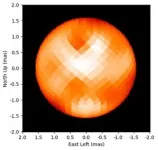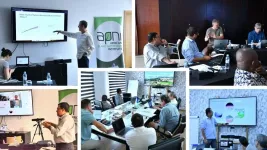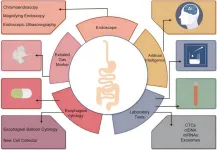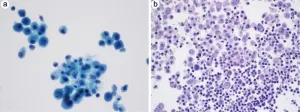(Press-News.org) ATLANTA — Researchers using Georgia State University’s Center for High Angular Resolution Astronomy (CHARA) Array have identified new details about the size and appearance of the North Star, also known as Polaris. The new research is published in The Astrophysical Journal.
Earth’s North Pole points to a direction in space marked by the North Star. Polaris is both a navigation aid and a remarkable star in its own right. It is the brightest member of a triple-star system and is a pulsating variable star. Polaris gets brighter and fainter periodically as the star’s diameter grows and shrinks over a four-day cycle.
Polaris is a kind of star known as a Cepheid variable. Astronomers use these stars as “standard candles” because their true brightness depends on their period of pulsation: Brighter stars pulsate slower than fainter stars. How bright a star appears in the sky depends on the star’s true brightness and the distance to the star. Because we know the true brightness of a Cepheid based on its pulsational period, astronomers can use them to measure the distances to their host galaxies and to infer the expansion rate of the universe.
A team of astronomers led by Nancy Evans at the Center for Astrophysics | Harvard & Smithsonian observed Polaris using the CHARA optical interferometric array of six telescopes at Mount Wilson, Calif. The goal of the investigation was to map the orbit of the close, faint companion that orbits Polaris every 30 years.
“The small separation and large contrast in brightness between the two stars makes it extremely challenging to resolve the binary system during their closest approach,” Evans said.
The CHARA Array combines the light of six telescopes that are spread across the mountaintop at the historic Mount Wilson Observatory. By combining the light, the CHARA Array acted like a 330-meter telescope to detect the faint companion as it passed close to Polaris. The observations of Polaris were recorded using the MIRC-X camera which was built by astronomers at the University of Michigan and Exeter University in the U.K. The MIRC-X camera has the remarkable ability to capture details of stellar surfaces.
The team successfully tracked the orbit of the close companion and measured changes in the size of the Cepheid as it pulsated. The orbital motion showed that Polaris has a mass five times larger than that of the Sun. The images of Polaris showed that it has a diameter 46 times the size of the Sun.
The biggest surprise was the appearance of Polaris in close-up images. The CHARA observations provided the first glimpse of what the surface of a Cepheid variable looks like.
CHARA Array false-color image of Polaris from April 2021 that reveals large bright and dark spots on the surface. Polaris appears about 600,000 times smaller than the Full Moon in the sky.
“The CHARA images revealed large bright and dark spots on the surface of Polaris that changed over time,” said Gail Schaefer, director of the CHARA Array. The presence of spots and the rotation of the star might be linked to a 120-day variation in measured velocity.
“We plan to continue imaging Polaris in the future,” said John Monnier, an astronomy professor at the University of Michigan. “We hope to better understand the mechanism that generates the spots on the surface of Polaris.”
The new observations of Polaris were made and recorded as part of the open access program at the CHARA Array, where astronomers from around the world can apply for time through the National Optical-Infrared Astronomy Research Laboratory (NOIRLab).
The CHARA Array is located at the Mount Wilson Observatory in the San Gabriel Mountains of southern California. The six telescopes of the CHARA Array are arranged along three arms. The light from each telescope is transported through vacuum pipes to the central beam combining lab. All the beams converge on the MIRC-X camera in the lab.
The CHARA Array open access program is funded by the National Science Foundation (grant AST-2034336). Institutional support for the CHARA Array is provided by Georgia State’s College of Arts & Sciences and the Office of the Vice President for Research and Economic Development.
For more information about Georgia State University research and its impact, visit research.gsu.edu. For more information about the CHARA Array visit: http://www.chara.gsu.edu/.
Contacts:
Nancy Evans (nevans@cfa.harvard.edu)
Gail Schaefer (gschaefer@gsu.edu)
END
New view of North Star reveals spotted surface
High-resolution images obtained with Georgia State University’s CHARA Array show large spots on the surface of Polaris
2024-08-20
ELSE PRESS RELEASES FROM THIS DATE:
UofL researchers gain $3.6 million to study and prevent effects of arsenic exposure
2024-08-20
University of Louisville researchers have received $3.6 million in new grant funding to study the role of arsenic exposure in causing cancer and other major health concerns. And, they think there’s a simple, off-the-shelf solution — zinc — that could help prevent some of its worst effects.
Arsenic is highly poisonous and occurs naturally in some rocks and soil. As a result, the most common source of exposure is drinking contaminated water, particularly ground water from private wells. More than 43 million people in the U.S. alone get their water from private wells, including many in areas of Kentucky that may be contaminated ...
Special issue of Criminology & Public Policy examines policing practice and policy
2024-08-20
The last two decades have been fraught for the policing profession, with police facing internal and external challenges to their public safety and legitimacy mandates. Much more research, analysis, and insights into policing are needed to inform policy, practice, and reforms in law enforcement and to achieve evidence-based policing. To move toward these goals, the current Editors-In-Chief of Criminology & Public Policy have published a second special issue on policing practice and policy, following their first special issue in 2020. This issue features thought-provoking and timely studies from leading researchers in the field on a variety of challenges facing ...
UBC research pinpoints how early-life antibiotics turn immunity into allergy
2024-08-20
Researchers at the University of British Columbia have shown for the first time how and why the depletion of microbes in a newborn's gut by antibiotics can lead to lifelong respiratory allergies.
In a study published today in the Journal of Allergy and Clinical Immunology, a research team from the school of biomedical engineering (SBME) has identified a specific cascade of events that lead to allergies and asthma. In doing so, they have opened many new avenues for exploring potential preventions and treatments.
"Our research finally shows how the gut bacteria and antibiotics shape a newborn's immune system to make them more prone to allergies," said ...
History professor examines Nelson Rockefeller’s career as a lens for Republican Party’s rightward shift
2024-08-20
CHAMPAIGN, Ill. — Politician and businessman Nelson Rockefeller was seen as a moderate or liberal Republican even as he embraced conservative policies as the Republican Party shifted to the right in the 1960s and ‘70s.
University of Illinois Urbana-Champaign history professor Marsha Barrett uses the political career of Rockefeller — the four-time New York governor and vice president to Gerald Ford — as a lens to explore the evolution of the Republican party and the ascendancy of conservatism in her new book, “Nelson Rockefeller’s Dilemma: The Fight to Save Moderate Republicanism.” ...
International workshop initiates review of opportunities for 4R nutrient stewardship in multifunctional, farmer-centric agricultural landscapes
2024-08-20
The review and writing sessions, held from July 22-25, 2024, gathered specialists from South and North America, Australia, Asia, Europe, and Africa. Participants brought expertise in the disciplines of water management, environmental data and modelling, crop nutrition including nitrogen and carbon, and farmer-centric agronomy.
“The strategic task for this group was to focus its attention on whether our understanding of landscape relationships between terrain, water, carbon, and changing farming objectives provides opportunities ...
The current status and prospects of early diagnosis and treatment of esophageal cancer in China
2024-08-20
Esophageal cancer, a highly aggressive malignancy originating in the esophageal epithelium, poses significant public health challenges in China, where it ranks sixth in incidence and fifth in mortality among cancers. The country's large population contributes to over half of the global cases and deaths from esophageal cancer. This cancer's poor prognosis is often due to late diagnosis, as early-stage esophageal cancer is typically asymptomatic, leading to diagnoses at more advanced stages. The geographical distribution of high-risk areas in China, such as the southern side of the ...
Nakkash & Griffin engaging Virginia youth & community in designing LGBTQ+ inclusive vaping prevention interventions
2024-08-20
Nakkash & Griffin Engaging Virginia Youth & Community In Designing LGBTQ+ Inclusive Vaping Prevention Interventions
Rima Nakkash, Professor, Global and Community Health, College of Public Health, and Kenneth Griffin, Professor, Global and Community Health, College of Public Health, received funding for the project: “Engaging Virginia youth and community in designing LGBTQ+ Inclusive Vaping Prevention Interventions.”
The researchers are developing evidence-based vaping prevention interventions tailored for LGBTQ+ youth in Virginia, informed by input from youth and stakeholders in this community.
Nakkash and Griffin ...
Cuellar examining negotiated rates for behavioral health & primary care providers
2024-08-20
Cuellar Examining Negotiated Rates For Behavioral Health & Primary Care Providers
Alison Cuellar, Associate Dean of Research, College of Public Health; Professor, Health Administration and Policy, received funding for the project: “Examining Negotiated Rates for Behavioral Health and Primary Care Providers.” The goal of the study is to inform future Medicaid policy by examining differences in how much payers reimburse for medical services in Virginia.
Cuellar is a Co-Investigator on the project with ...
USPSTF statement on screening and supplementation for iron deficiency and iron deficiency anemia during pregnancy
2024-08-20
Bottom Line: The U.S. Preventive Services Task Force (USPSTF) concludes that the current evidence is insufficient to assess the balance of benefits and harms of screening and routine supplementation for iron deficiency and iron deficiency anemia in pregnant persons to prevent adverse maternal and infant health outcomes. Iron deficiency is the leading cause of anemia during pregnancy. According to survey data from 1999 to 2006, overall estimated prevalence of iron deficiency during pregnancy is near 18% and increases across the three trimesters of pregnancy. An estimated 5% of pregnant ...
The International System for reporting serous fluid cytopathology—an updated review
2024-08-20
Serous effusion, defined as the excessive accumulation of fluid in body cavities such as the pleural, pericardial, and peritoneal spaces, is a critical diagnostic challenge in pathology. Cytological evaluation of serous fluids provides vital information for detecting underlying etiologies, such as malignancy, and helps in evaluating tumor stages and customizing treatment plans. To address inconsistencies in the diagnostic criteria and nomenclature used in fluid cytology reporting, the International Academy of Cytology and the American Society of Cytopathology introduced The International ...
LAST 30 PRESS RELEASES:
Numbers in our sights affect how we perceive space
SIMJ announces global collaborative book project in commemoration of its 75th anniversary
Air pollution exposure and birth weight
Obstructive sleep apnea risk and mental health conditions among older adults
How talking slows eye movements behind the wheel
The Ceramic Society of Japan’s Oxoate Ceramics Research Association launches new international book project
Heart-brain connection: international study reveals the role of the vagus nerve in keeping the heart young
Researchers identify Rb1 as a predictive biomarker for a new therapeutic strategy in some breast cancers
Survey reveals ethical gaps slowing AI adoption in pediatric surgery
Stimulant ADHD medications work differently than thought
AI overestimates how smart people are, according to HSE economists
HSE researchers create genome-wide map of quadruplexes
Scientists boost cell "powerhouses" to burn more calories
Automatic label checking: The missing step in making reliable medical AI
Low daily alcohol intake linked to 50% heightened mouth cancer risk in India
American Meteorological Society announces Rick Spinrad as 2026 President-Elect
Biomass-based carbon capture spotlighted in newly released global climate webinar recording
Illuminating invisible nano pollutants: advanced bioimaging tracks the full journey of emerging nanoscale contaminants in living systems
How does age affect recovery from spinal cord injury?
Novel AI tool offers prognosis for patients with head and neck cancer
Fathers’ microplastic exposure tied to their children’s metabolic problems
Research validates laboratory model for studying high-grade serous ovarian cancer
SIR 2026 delivers transformative breakthroughs in minimally invasive medicine to improve patient care
Stem Cell Reports most downloaded papers of 2025 highlight the breadth and impact of stem cell research
Oxford-led study estimates NHS spends around 3% of its primary and secondary care budget on the health impacts of heat and cold in England
A researcher’s long quest leads to a smart composite breakthrough
Urban wild bees act as “microbial sensors” of city health.
New study finds where you live affects recovery after a hip fracture
Forecasting the impact of fully automated vehicle adoption on US road traffic injuries
Alcohol-related hospitalizations from 2016 to 2022
[Press-News.org] New view of North Star reveals spotted surfaceHigh-resolution images obtained with Georgia State University’s CHARA Array show large spots on the surface of Polaris






